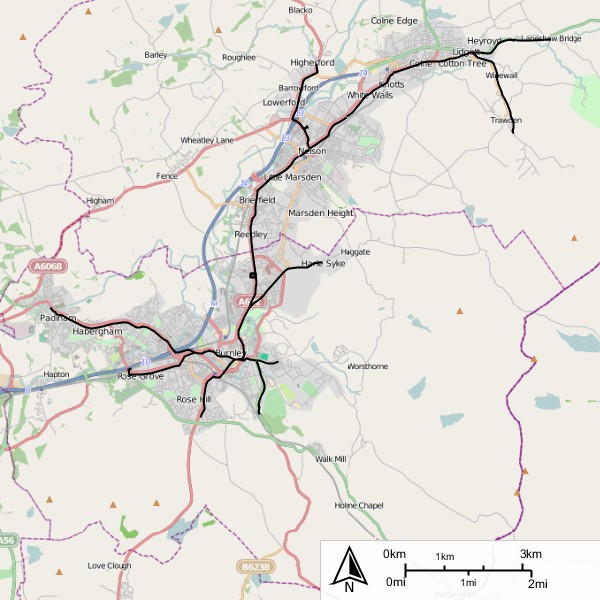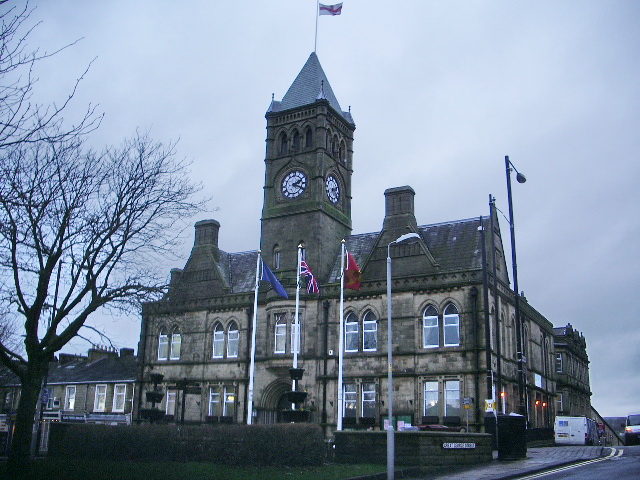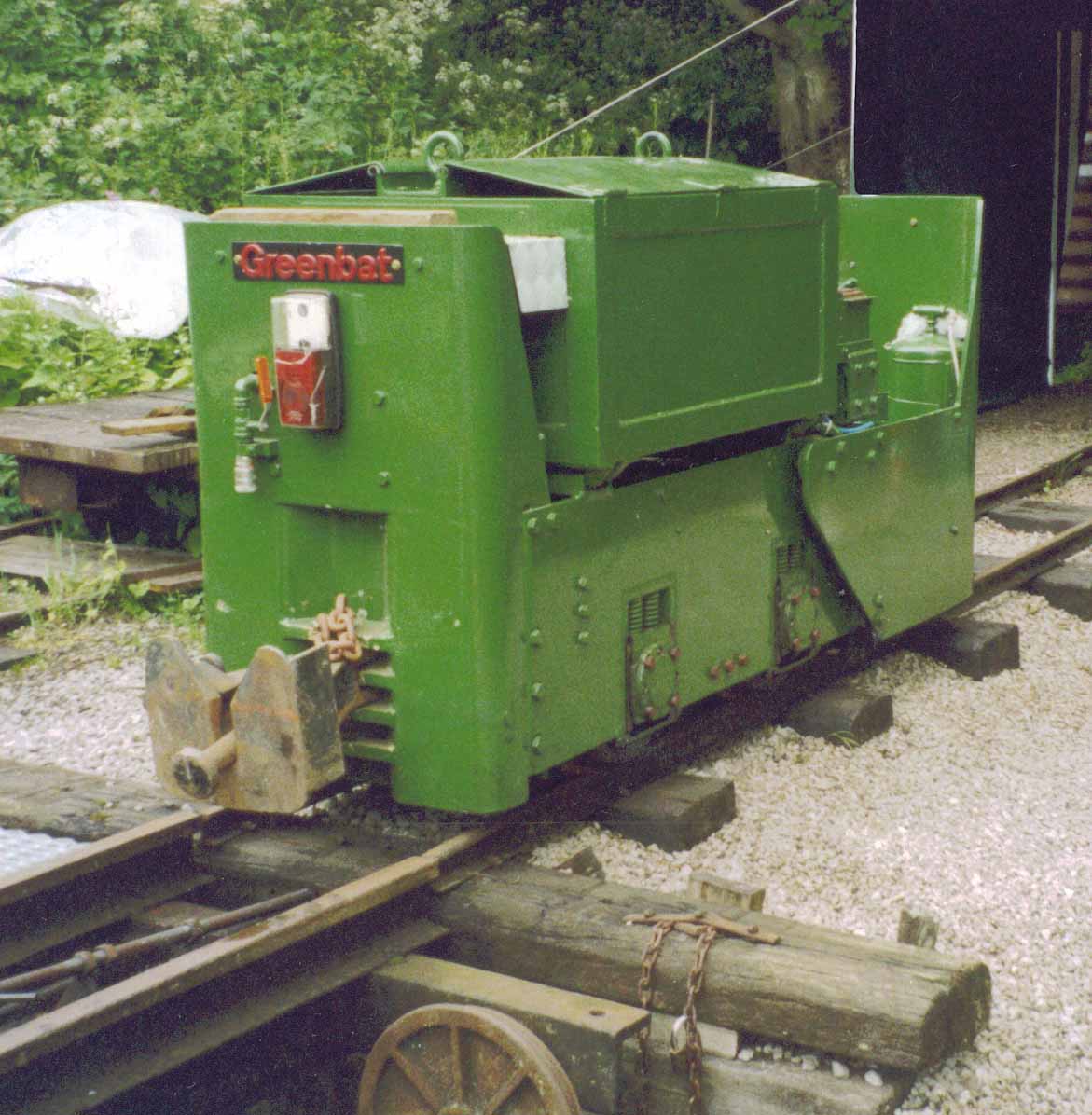|
Colne And Trawden Light Railway Company
The Colne and Trawden Light Railway Company operated a tramway service in Colne and Trawden between 1903 and 1934. History The tramway was authorised by the Colne and Trawden Light Railway Order of 1901. It was built and operated by Greenwood & Batley Greenwood & Batley were a large engineering manufacturer with a wide range of products, including armaments, electrical engineering, and printing and milling machinery. They also produced a range of battery-electric railway locomotives under the ... of Leeds. Nuttal and Co were contractors for the permanent way, and R.W. Blackwell for the overhead wiring. Construction started on 19 May 1903 when the Mayor of Colne, Alderman Varley, cut the first sod. Services started on the first section on 28 November 1903, and other sections opened in stages until the line reached Zion Chapel on Lane House Lane, Trawden by December 1905. A branch to Laneshawbridge opened by the end of December 1904. The system connected with Nelson Corporat ... [...More Info...] [...Related Items...] OR: [Wikipedia] [Google] [Baidu] |
Colne
Colne () is a market town and civil parish in the Borough of Pendle in Lancashire, England. Located northeast of Nelson, north-east of Burnley, east of Preston and west of Leeds. The town should not be confused with the unrelated Colne Valley around the River Colne near Huddersfield in West Yorkshire. Colne is close to the southern entrance to the Aire Gap, the lowest crossing of the Pennine watershed. The M65 terminates west of the town and from here two main roads take traffic onwards towards the Yorkshire towns of Skipton (A56) and Keighley (A6068). Colne railway station is the terminus of the East Lancashire railway line. Colne adjoins the Pendle parishes of Foulridge, Laneshaw Bridge, Trawden Forest, Nelson, Barrowford and Blacko. History Settlement in the area can be traced back to the Stone Age. A Mesolithic camp site, a Bronze Age burial site and stone tools from the Bronze and Stone Ages have been discovered at nearby Trawden. There are also the remains of an I ... [...More Info...] [...Related Items...] OR: [Wikipedia] [Google] [Baidu] |
Trawden
Trawden is a village in the Trawden Forest parish of Pendle, at the foot of Boulsworth Hill, in Lancashire, England. The village co-operatively owns and runs its library, shop, community centre and pub. Activities As a way of encouraging people to visit Trawden and the surrounding area, a small group of village residents organise and mobilise other villagers in order to hold the annual Trawden Garden Festival and Scarecrow Trail. This takes place over the first weekend in July. Trawden also holds an annual agricultural show on the 2nd Sunday in August, which many farmers, riders and people from around Lancashire enjoy and take part in. Trawden F.C. were champions of the Pendle Charity League Second Division in the 2006–07 season. Trawden Athletic Club is a running club consisting of around 400 members (as of January 2017) who compete in local and regional road, fell, trail and cross country races. The Trawden Forest Community Centre is in the heart of the village. The Ce ... [...More Info...] [...Related Items...] OR: [Wikipedia] [Google] [Baidu] |
Heifer Lane Tram Depot, Colne
Heifer may refer to: * Heifer (cow), a young cow before she has had her first calf * Frank Heifer (1854–1893), American outfielder and first baseman * ''The Heifer ''La vaquilla'' (English: ''The Heifer'') is a 1985 Spanish comedy film written and directed by Luis García Berlanga. It was the first comedy made about the Spanish Civil War and the highest-grossing Spanish film in Spain at the time surpassing ' ...'' (''La vaquilla''), 1985 Spanish comedy film * Heifer International, a charitable organization * Red heifer, in Christianity or Judaism, was a heifer that was sacrificed and whose ashes were used for the ritual purification See also * Heffer (other) {{disambiguation, surname ... [...More Info...] [...Related Items...] OR: [Wikipedia] [Google] [Baidu] |
Greenwood & Batley
Greenwood & Batley were a large engineering manufacturer with a wide range of products, including armaments, electrical engineering, and printing and milling machinery. They also produced a range of battery-electric railway locomotives under the brand name ''Greenbat''. The works was in Armley, Leeds, UK. Introduction Thomas Greenwood and John Batley first set up their business in 1856, both having previously worked at Fairburn's Wellington Foundry in Leeds. Their first premises, the Albion Foundry, was taken over from Thomas W. Lord. The foundry was located on East Street by the River Aire ( Aire & Calder Navigation), however this quickly became too small for their needs and in 1859 they constructed the Albion Works in Armley Road, Leeds. In 1885 the company branched out into Flour and Oil Milling Machinery as a result of the acquisition of the business of Joseph Whitham, Perseverance Iron Works, Kirkstall Road, Leeds. By 1888 the works covered and employed around 1600 me ... [...More Info...] [...Related Items...] OR: [Wikipedia] [Google] [Baidu] |
Laneshawbridge
Laneshawbridge (otherwise Laneshaw Bridge) is a village and civil parish in the Borough of Pendle in England. The population of the civil parish at the 2011 census was 918. It is to the east of Colne in Lancashire and is the easternmost settlement in Lancashire on the main road route, before the North Yorkshire border. The roots of Laneshawbridge, or “The Brig” as it is affectionately known by the locals, date from the time of William the Conqueror, when he gave some land to the Emmott family, which they still own. It is thought that the family were given land for their military support, and founded a hamlet known as “Eamot” which later became Laneshawbridge. The family resided at Emmott Hall, the first of which dated back to 1310, but it was to be modified, rebuilt and finally demolished in 1967. Near to where the hall stood is Emmott House, which was a coach house to the main hall and dates back to 1737. In the 1990s, the old boating lake was dug out to create Hullow ... [...More Info...] [...Related Items...] OR: [Wikipedia] [Google] [Baidu] |
Nelson Corporation Tramways
Nelson Corporation Tramways operated a tramway service in Nelson, Lancashire between 1903 and 1934. History The tramway was authorised by the Nelson Light Railway Order of 1901 The tramway route ran along the Leeds Road from the town centre to the boundary with Colne (to connect with the Colne and Trawden Light Railway. It also connected with the Burnley Corporation Tramways network. There was also a branch line, from Scotland Road to Higherford Bridge. Electricity was supplied from Nelson power station. In 1912, the company obtained two low height tramcars which could pass underneath the low bridge carrying the railway in Colne, and through services to Colne were initiated. In 1924, the Barrowford section of the tramway was relaid after a proposal to substitute with buses was rejected.The Electrical journal, Volume 92, 1924 Fleet The company livery was red and white. Eight vehicles were purchased as follows: *1-6 Brush Electrical Machines, Loughborough1903. Double dec ... [...More Info...] [...Related Items...] OR: [Wikipedia] [Google] [Baidu] |
Brush Electrical Machines
Brush Electrical Machines is a manufacturer of electrical generators typically for gas turbine and steam turbine driven applications. The main office is based at Loughborough in Leicestershire, UK. History Charles Francis Brush, born in Euclid Township, Ohio in 1849, founded the Brush Electric Light Company, which stayed in business in the U.S. until 1889 when it was absorbed into the Thomson-Houston Company making Brush a wealthy man. In 1880, the Anglo-American Brush Electric Light Corporation was established in Lambeth, London. Its formation was to exploit the invention of Brush's first electric dynamo in 1876. As the business grew, due to the demand for new electrical apparatus, larger premises were sought, and in 1889 the corporation moved 100 miles north into the newly acquired Falcon Engine and Car Works at Loughborough under the new name, Brush Electrical Engineering Company Limited. In 1914, the company began manufacturing Ljungstrom steam turbines under licence. Ov ... [...More Info...] [...Related Items...] OR: [Wikipedia] [Google] [Baidu] |
Milnes Voss
G. F. Milnes & Co. Ltd was a tramcar manufacturer based in Birkenhead (1886–1902) and Hadley, Shropshire (1900–1905) Starbuck Car and Wagon Company George Starbuck established the first tramcar manufacturing business in Britain at 227 Cleveland Street, Birkenhead. It was incorporated as George Starbuck and Company on 12 September 1871. It was re-registered one year later as Starbuck Car and Wagon Company Ltd., on 6 November 1872. In 1878 George Frederick Milnes of Liverpool, became Company Secretary and in 1886 purchased the factory and assets following the winding-up of the Company. The business was renamed George F. Milnes and Co. and they evolved into successful tramcar manufacturers, with customers throughout Britain and a substantial export trade. G.F. Milnes & Co On 10 September 1898 the business was registered as a limited company, and the following year the site for a new and larger works (Castle Car Works) was purchased at Hadley, Shropshire. Production commenc ... [...More Info...] [...Related Items...] OR: [Wikipedia] [Google] [Baidu] |
United Electric Car Company
The United Electric Car Company was a tramcar manufacturer from 1905 to 1917 in Preston, Lancashire, England. History The Electric Railway and Tramway Carriage Works was formed in 1897 registered on 25 April 1898 to acquire works at Preston, Lancashire. It was founded by two Scots, W. B. Dick and John Kerr. They formed a new company, English Electrical Manufacturing based in a new West Works on Strand Road, Preston in 1900, to build the electric motors for their trams. In 1905 the Electric Railway and Tramway Carriage Works took over two other works, including G.F. Milnes & Co. in Hadley, Shropshire, the name being then changed to United Electric Car Co. By 1914, the company employed around 2,000 people. They produced electrical equipment for tramways and railways and built over 8,000 tramcars, for service in the UK and abroad, including to the Hong Kong Tramways and Buenos Aires tramways operated by the Anglo-Argentine Tramways Company. [...More Info...] [...Related Items...] OR: [Wikipedia] [Google] [Baidu] |
Tram Transport In England
A tram (called a streetcar or trolley in North America) is a rail vehicle that travels on tramway tracks on public urban streets; some include segments on segregated right-of-way. The tramlines or networks operated as public transport are called tramways or simply trams/streetcars. Many recently built tramways use the contemporary term light rail. The vehicles are called streetcars or trolleys (not to be confused with trolleybus) in North America and trams or tramcars elsewhere. The first two terms are often used interchangeably in the United States, with ''trolley'' being the preferred term in the eastern US and ''streetcar'' in the western US. ''Streetcar'' or ''tramway'' are preferred in Canada. In parts of the United States, internally powered buses made to resemble a streetcar are often referred to as "trolleys". To avoid further confusion with trolley buses, the American Public Transportation Association (APTA) refers to them as "trolley-replica buses". In the United ... [...More Info...] [...Related Items...] OR: [Wikipedia] [Google] [Baidu] |





